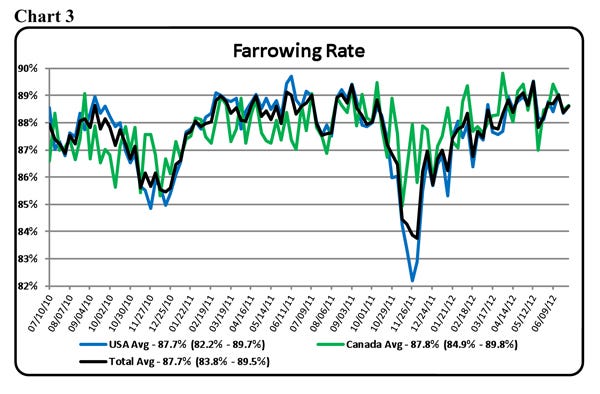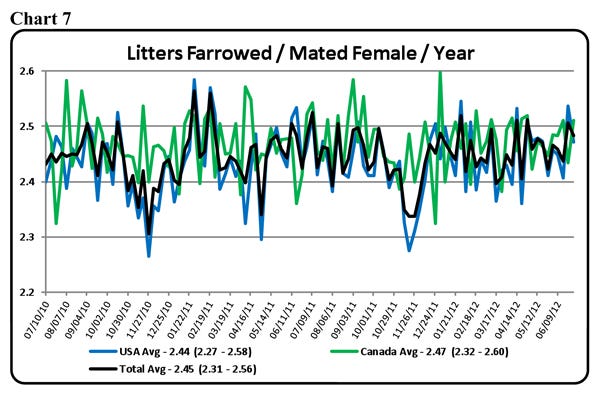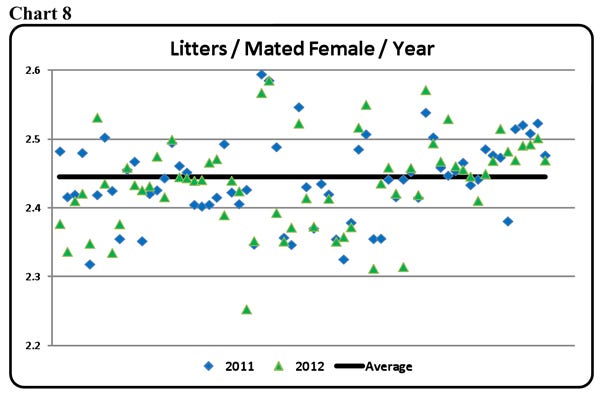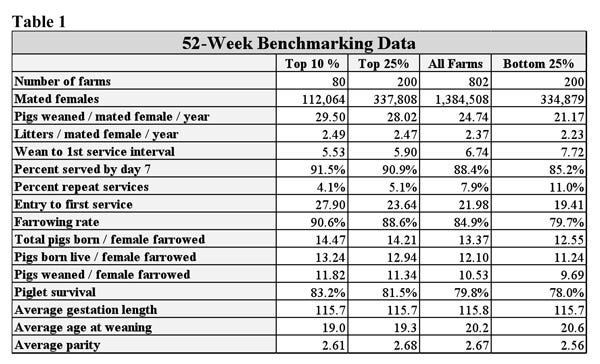Keep Tabs on Seasonal Effects on Female Performance
Have you ever taken a look at seasonal effects on key performance indicators such as percent repeat services, farrowing rate, farrow-to-farrow interval, litters farrowed/mated female/year or litter farrowed/crate/year?
November 5, 2012

Have you ever taken a look at seasonal effects on key performance indicators such as percent repeat services, farrowing rate, farrow-to-farrow interval, litters farrowed/mated female/year or litter farrowed/crate/year? Have improvements in facility design, better cooling methods and genetic improvements lowered the seasonal effects on performance?
For this and the next few articles, we have selected 66 farms from the Swine Management Services database, which represents 178,454 sows. Forty-six of those farms are located in the United States (125,834 sows) and 20 farms are in Canada (52,620 sows). We pulled detailed data from the last 104 weeks ending June 30, 2012. With two years of data broken down by week, we can see whether seasonal effects are influencing performance.
Percent Repeat Services
Charts 1 and 2 show a seasonal pattern in repeat services – a drop in percent repeats in May-June and a spike in repeats in late fall, generally caused by the hot summer months.


Chart 1 shows the percent of repeats did not affect females in the summer of 2010 as much as the summer of 2011, when repeats in U.S. farms reached 9.4%. The percent weekly repeat average was 6.1% with a range of 4.7 to 8.5%. When we compared U.S. and Canadian herds, there was not much difference in average or ranges.
There are many reasons why some farms have more repeats in late summer than others, but we feel sow body condition coming out of farrowing accounts for some of the problem. Semen quality and handling should also be considered. Boars in studs are exposed to more stress in the summer and, therefore, produce lower quality semen. And the hot weather presents challenges with semen delivery, controlling temperature fluctuation in semen storage units and proper semen handling.
Chart 2 shows the large variation in percent repeats (1% to 16.7%). In the chart, each farm has a percent for 2011 and 2012. For example, the first farm was at 4% in 2011 and 7% in 2012.
Farrowing Rate
Everyone knows farrowing rate is affected by the summer heat. Chart 3 reinforces that inseminations from mid-July to early-September have a negative effect on farrowing rates in November and December. The summer of 2011 was hotter than normal and caused a large drop in farrowing rate for U.S. farms. Canadian farms were less affected.
The farrowing rate average for the 66 U.S. and Canadian farms was very good at 87.7%, with weekly averages ranging from 82.2 to 89.7% for the two-year period. Canada appears to have some advantage by not having the extreme heat that U.S. producers cope with.

Chart 4 shows the variation in farrowing rate by farm with the top farm at 94.6% and the bottom farm at 81% for a 52-week period.

Remember, farrowing rate is a three-part variable with semen, sow and breeding technician all having an effect on getting the females pregnant.
Farrow-to-Farrow Interval
Farrow-to-farrow interval is the time period from when the female farrowed until she farrows again. Chart 5 shows the 104-week average at 144.4 days, ranging from 143.2 to 145.7 days. Again, there is some seasonal impact, with intervals increasing from late-December to late-March.

The intervals reflect the increase in repeat matings from late-August to sometimes early-October. Sows that recycle and are rebred cause this number to increase. It is interesting to note that the farrow-to-farrow interval is about two days lower on Canadian farms.
Again, there is a lot of variation between farms – the top farms coming in at less than 140 days, farrow-to-farrow, while others average more than 148 days (Chart 6). With open sow days estimated to cost about $2.50/sow/day, some of the farms are losing some big dollars.

Litters Farrowed/Mated Female/Year
Charts 7 and 8, litters farrowed/mated female/year, show the 66 farms averaged 2.44 litters, with a top weekly average of 2.58 to a low of 2.27 litters. Once again, there is very little difference between U.S. and Canadian farms.
In Chart 7, there is week-to-week variation with some drop in late fall due to the summer breeding period and a drop in farrowing rate causing an increase in repeats.

Chart 8 shows the wide variation – from a farm at 2.25 litters/mated female/year in 2012 to the top farm at 2.60 litters in 2011.

Litters/Farrow Crate/Year
Charts 9 and 10 take a closer look at the efficiency of farms to move more litters through the farrowing crates. The average was 14.21 litters/farrowing crate/year, with a range of 13.19 to 14.82 litters/farrowing crate/year.
Canadian producers are doing a better job and averaging 1.96 more litters/farrowing crate/year than their U.S. counterparts. We feel some of this difference can be attributed to weaning age averages being about two days older.
Chart 10 shows a few farms at only 10-12 turns/farrowing crate/year, with a lot of farms averaging 15 to 16.5 turns. In recent years, there has been some drop in litters farrowed/crate/year as weaning ages increase to produce bigger pigs for the nursery-finisher area, helping to lower feed costs and improve performance.


Clearly, some performance indicators are affected by season. The biggest effect is summer heat, which can lower farrowing rate and, in turn, increase the number of repeat females and the farrow-to-farrowing interval. Keep close tabs on farrowing performance over the next couple of months to see if summer breeding procedures need to be adjusted to reduce their impact on breeding success.
Editor’s note: Past Production Preview columns can be found at: www.nationalhogfarmer.com; click on “newsletters,” then the respective date of the Weekly Preview issue you are interested in.
Key Performance Indicators
Tables 1 and 2 (below) provide 52-week and 13-week rolling averages for key performance indicators (KPI) of breeding herd performance. These tables reflect the most current quarterly data available and are presented with each column. The KPI’s can be used as general guidelines to measure the productivity of your herd compared to the top 10% and top 25% of farms, the average performance for all farms and the bottom 25% of farms in the SMS database.


If you have questions or comments about these columns, or if you have a specific performance measurement that you would like to see benchmarked in our database, please address them to: [email protected] or [email protected].
Mark Rix and Ron Ketchem Swine Management Services, LLC
You May Also Like



